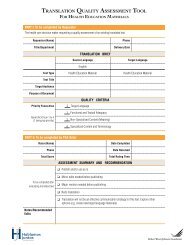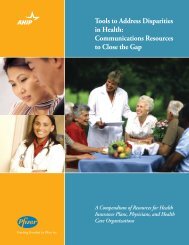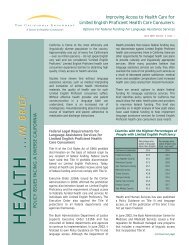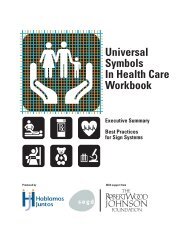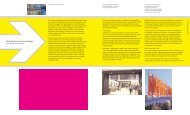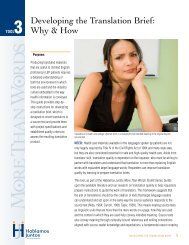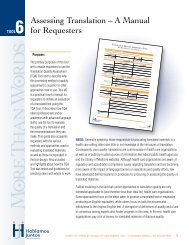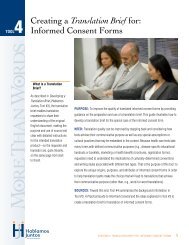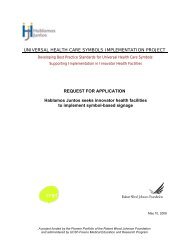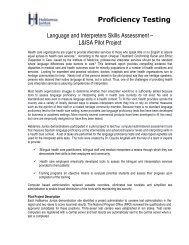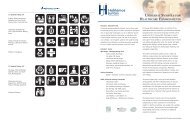Language Use and English-Speaking Ability: 2000 - Census Bureau
Language Use and English-Speaking Ability: 2000 - Census Bureau
Language Use and English-Speaking Ability: 2000 - Census Bureau
You also want an ePaper? Increase the reach of your titles
YUMPU automatically turns print PDFs into web optimized ePapers that Google loves.
Linguistically Isolated<br />
Households<br />
A linguistically isolated household<br />
is one in which no person<br />
aged 14 or over speaks<br />
<strong>English</strong> at least “Very well.”<br />
That is, no person aged 14 or<br />
over speaks only <strong>English</strong> at<br />
home, or speaks another language<br />
at home <strong>and</strong> speaks<br />
<strong>English</strong> “Very well.”<br />
A linguistically isolated person<br />
is any person living in a<br />
linguistically isolated household.<br />
All the members of a<br />
linguistically isolated household<br />
are tabulated as linguistically<br />
isolated, including<br />
members under 14 years old<br />
who may speak only <strong>English</strong>.<br />
could also affect other activities<br />
outside the home, such as grocery<br />
shopping or banking. People who<br />
do not have a strong comm<strong>and</strong> of<br />
<strong>English</strong> <strong>and</strong> who do not have<br />
someone in their household to<br />
help them on a regular basis are at<br />
even more of a disadvantage.<br />
They are defined here as “linguistically<br />
isolated” (see text box<br />
above).<br />
In <strong>2000</strong>, 4.4 million households<br />
encompassing 11.9 million people<br />
were linguistically isolated. These<br />
numbers were significantly higher<br />
than in 1990, when 2.9 million<br />
households <strong>and</strong> 7.7 million people<br />
lived in those households.<br />
ABOUT CENSUS <strong>2000</strong><br />
Why <strong>Census</strong> <strong>2000</strong> Asked<br />
About <strong>Language</strong> <strong>Use</strong> <strong>and</strong><br />
<strong>English</strong>-<strong>Speaking</strong> <strong>Ability</strong><br />
The question on language use <strong>and</strong><br />
<strong>English</strong>-speaking ability provides<br />
government agencies with information<br />
for programs that serve the<br />
needs of people who have difficulty<br />
speaking <strong>English</strong>. Under the Voting<br />
Rights Act, information about language<br />
ability is needed to meet<br />
statutory requirements for making<br />
voting materials available in<br />
minority languages.<br />
The Bilingual Education Program<br />
uses data on language to allocate<br />
grants to school districts for children<br />
with limited <strong>English</strong> proficiency.<br />
These data also are needed for<br />
local agencies developing services<br />
for the elderly under the Older<br />
Americans Act.<br />
Accuracy of the Estimates<br />
The data contained in this report<br />
are based on the sample of households<br />
who responded to the<br />
<strong>Census</strong> <strong>2000</strong> long form.<br />
Nationally, approximately 1 out of<br />
every 6 housing units was included<br />
in this sample. As a result, the<br />
sample estimates may differ somewhat<br />
from the 100-percent figures<br />
that would have been obtained if<br />
all housing units, people within<br />
those housing units, <strong>and</strong> people<br />
living in group quarters had been<br />
enumerated using the same questionnaires,<br />
instructions, enumerators,<br />
<strong>and</strong> so forth. The sample<br />
estimates also differ from the values<br />
that would have been obtained<br />
from different samples of housing<br />
units, people within those housing<br />
units, <strong>and</strong> people living in group<br />
quarters. The deviation of a sample<br />
estimate from the average of<br />
all possible samples is called the<br />
sampling error.<br />
In addition to the variability that<br />
arises from the sampling procedures,<br />
both sample data <strong>and</strong> 100-<br />
percent data are subject to nonsampling<br />
error. Nonsampling error<br />
may be introduced during any of<br />
the various complex operations<br />
used to collect <strong>and</strong> process data.<br />
Such errors may include: not enumerating<br />
every household or every<br />
person in the population, failing to<br />
obtain all required information<br />
from the respondents, obtaining<br />
incorrect or inconsistent information,<br />
<strong>and</strong> recording information<br />
incorrectly. In addition, errors can<br />
occur during the field review of the<br />
enumerators’ work, during clerical<br />
h<strong>and</strong>ling of the census questionnaires,<br />
or during the electronic<br />
processing of the questionnaires.<br />
Nonsampling error may affect the<br />
data in two ways: (1) errors that<br />
are introduced r<strong>and</strong>omly will<br />
increase the variability of the data<br />
<strong>and</strong>, therefore, should be reflected<br />
in the st<strong>and</strong>ard errors; <strong>and</strong> (2)<br />
errors that tend to be consistent in<br />
one direction will bias both sample<br />
<strong>and</strong> 100-percent data in that direction.<br />
For example, if respondents<br />
consistently tend to underreport<br />
their incomes, then the resulting<br />
estimates of households or families<br />
by income category will tend<br />
to be understated for the higher<br />
income categories <strong>and</strong> overstated<br />
for the lower income categories.<br />
Such biases are not reflected in the<br />
st<strong>and</strong>ard errors.<br />
While it is impossible to completely<br />
eliminate error from an operation<br />
as large <strong>and</strong> complex as the decennial<br />
census, the <strong>Census</strong> <strong>Bureau</strong><br />
attempts to control the sources of<br />
such error during the data collection<br />
<strong>and</strong> processing operations.<br />
The primary sources of error <strong>and</strong><br />
the programs instituted to control<br />
error in <strong>Census</strong> <strong>2000</strong> are described<br />
in detail in Summary File 3<br />
Technical Documentation under<br />
Chapter 8, “Accuracy of the Data,”<br />
located at www.census.gov<br />
/prod/cen<strong>2000</strong>/doc/sf3.pdf.<br />
All statements in this <strong>Census</strong> <strong>2000</strong><br />
Brief have undergone statistical<br />
testing <strong>and</strong> all comparisons are<br />
significant at the 90-percent confidence<br />
level, unless otherwise<br />
noted. The estimates in tables,<br />
maps, <strong>and</strong> other figures may vary<br />
10 U.S. <strong>Census</strong> <strong>Bureau</strong>



